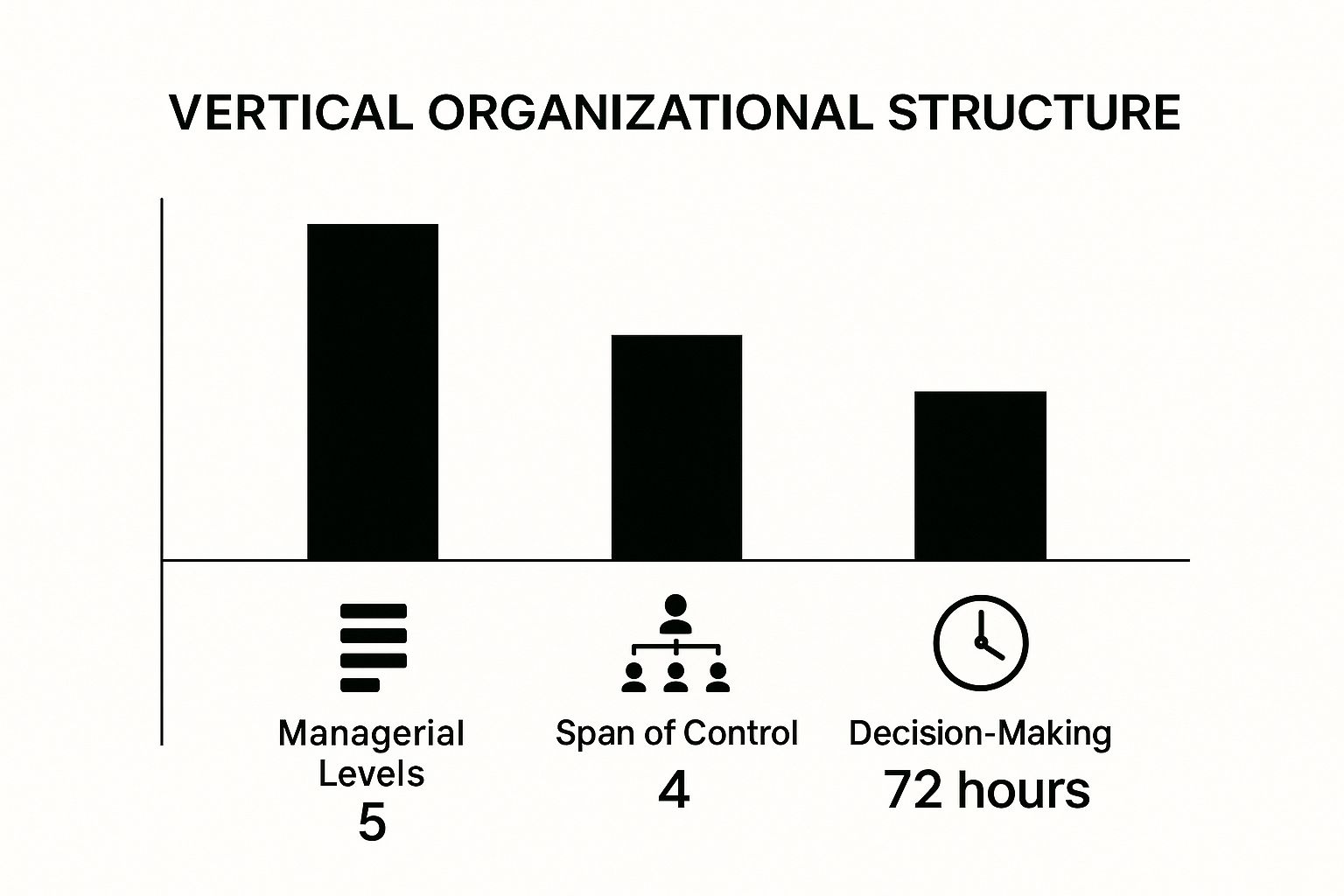Vertical Organizational Structure: Key Insights for Leaders
Demystifying Vertical Organizational Structure

A vertical organizational structure, also known as a hierarchical structure, is a traditional organizational model. It features a clear chain of command flowing downwards and accountability flowing upwards, visually resembling a pyramid. At the very top sits the top management, such as the CEO or President.
Understanding the Hierarchy
Below the top level, you’ll find middle management, including department heads and supervisors. These individuals take the strategic decisions made at the top and translate them into actionable operational tasks. At the base of the pyramid are the employees who perform these tasks, forming the foundation of the organization’s workflow.
For example, imagine a manufacturing company. The CEO sets the overall production targets. The production manager then breaks down these targets into departmental goals, which are then assigned to individual workers on the assembly line.
This structured approach offers a clear understanding of authority. It clearly defines who makes decisions, who executes them, and who is ultimately responsible for the results.
This structure also facilitates the creation of specialized departments, allowing individuals to develop significant expertise within their specific areas. Formalized communication channels are another important aspect, ensuring information flows efficiently throughout the organization.
Vertical vs. Other Structures
Vertical structures differ significantly from horizontal and matrix structures. A horizontal structure distributes authority across teams and emphasizes collaboration. A matrix structure blends elements of both vertical and horizontal structures, with employees reporting to both functional and project managers.
This means a vertical structure is best suited for organizations that prioritize strong control and well-defined lines of authority. Horizontal structures, on the other hand, are better suited for environments requiring flexibility and innovation.
The Indian Statistical System provides a practical example of a vertically decentralized model. Centralized agencies handle large-scale operations, such as the Population Census, while state-level departments manage day-to-day data collection and processing. This multi-tiered system allows for both centralized oversight and localized execution. Learn more about the Indian Statistical System here.
However, the rigid nature of vertical structures can sometimes lead to communication silos and limited flexibility. These potential drawbacks must be carefully managed for optimal organizational performance.
Strategic Advantages That Drive Vertical Structure Adoption

The infographic above illustrates the core structural elements of a vertical organization. These include managerial levels, span of control, and decision-making time. A typical vertical structure features 5 tiers of management, a span of control of 4 direct reports, and a structured decision-making process that can take up to 72 hours. This structured approach helps establish clear lines of authority and responsibility, leading to several strategic benefits.
Clear Lines of Authority and Accountability
A significant advantage of the vertical organizational structure is its clear definition of authority. This clarity minimizes confusion about decision-making power. Everyone knows their position within the organization and who they report to.
This structure also promotes accountability. Each level in the hierarchy is responsible for specific results, creating a sense of ownership. Communication also improves, flowing efficiently up and down the chain of command.
Enhanced Decision-Making Efficiency
Vertical structures contribute to efficient decision-making, particularly when fast action is required. While decisions originate at the top, the hierarchy facilitates quick dissemination and implementation throughout the company. This speed is especially vital in rapidly changing industries demanding quick reactions to market shifts.
However, potential bottlenecks can arise. To address this, some Indian companies grant middle management decision-making authority within specific parameters.
Fostering Specialized Expertise and Career Growth
The hierarchical design of vertical structures promotes specialization within individual departments. By concentrating on particular tasks and functions, employees can develop deep expertise in their respective areas, leading to higher quality work and improved efficiency.
Vertical structures typically offer clear career paths. The distinct levels create a roadmap for advancement, motivating employees and potentially reducing turnover. For more insights on career advancement and recruitment, check out: How to master recruitment on taggd.in.
Strategic Resource Allocation and Performance Monitoring
Vertical structures make strategic resource allocation easier. Leadership gains a clear understanding of departmental needs and priorities, which enables them to distribute resources efficiently. This centralized approach simplifies performance monitoring as well.
Managers can readily track individual and team performance against objectives. This allows for timely feedback and adjustments, driving continuous improvement and alignment with overarching strategic goals. Many Indian manufacturing companies use this model to enhance production efficiency and quality control.
The table below summarizes the benefits of a vertical organizational structure compared to horizontal and matrix structures.
Benefits of Vertical Organizational Structure
| Benefit Category | Vertical Structure | Horizontal Structure | Matrix Structure |
|---|---|---|---|
| Clear Authority & Accountability | High | Lower, more collaborative | Shared, potential for conflict |
| Decision-Making Efficiency | Fast, top-down | Slower, consensus-based | Moderate, can be complex |
| Specialized Expertise | Encouraged, deep expertise | Broader skill sets, less depth | Mix of specialized and general skills |
| Career Progression | Clearly defined path | Less structured, lateral movement | Multiple reporting lines, diverse opportunities |
| Resource Allocation | Centralized, efficient | Decentralized, flexible | Shared resources, potential for competition |
| Performance Monitoring | Straightforward, top-down | Peer-based, multi-directional | Complex, multiple evaluations |
This table highlights how a vertical structure excels in clarity of authority and decision-making speed, while horizontal and matrix structures offer benefits in areas like collaboration and skill diversification. Choosing the best structure depends on the specific needs and goals of each organization.
Navigating the Hidden Pitfalls of Vertical Structures

While vertical organizational structures offer many benefits, they also come with their own set of potential challenges. Understanding these pitfalls is key to mitigating their negative impact and ensuring the structure remains effective.
The Challenge of Market Responsiveness
One significant drawback of a vertical organizational structure is its potential to slow down market responsiveness. Decisions often need approval from multiple layers of management, which can create a long and complex process. This can be a real disadvantage in fast-paced markets where quick reactions are crucial. For example, imagine a competitor launches a sudden, aggressive pricing change. A company with a rigid vertical structure might struggle to react quickly enough, potentially losing valuable market share.
Communication Silos and Stifled Collaboration
Vertical structures can unintentionally create communication silos, isolating different departments and hindering cross-functional teamwork. This happens when communication flows primarily up and down the chain of command, with limited horizontal interaction. This isolation can lead to duplicated work, missed opportunities, and internal disagreements. Picture a marketing team designing a new product campaign without talking to the sales team about what customers are actually saying. This lack of collaboration could easily lead to a campaign that misses the mark. For more insights on collaboration challenges, you might find these Case studies on Taggd.in helpful.
Bureaucracy and its Impact
Excessive bureaucracy, a common consequence of vertical structures, can negatively impact a company’s ability to move quickly and engage its employees. Too many layers of approvals and rigid procedures can stifle innovation and make it difficult for people to take initiative. This can result in frustrated employees, lower motivation, and even increased turnover. This bureaucratic environment can also make it harder for the company to adapt to evolving market conditions.
Addressing the Pitfalls
Fortunately, these challenges can be minimized. Implementing selective decentralization can empower middle managers to make decisions within defined parameters, improving responsiveness. Encouraging cross-functional teams and open communication channels can break down silos and encourage collaboration. Streamlining internal processes and cutting back on unnecessary approvals can reduce bureaucracy and increase agility.
Practical Solutions from Indian Organizations
Several Indian organizations have successfully tackled these issues. Some have adopted a hybrid approach, keeping the vertical structure for key functions but adding horizontal elements for specific projects or new initiatives. This lets them maintain control and stability while also encouraging innovation and collaboration. Other organizations have used internal communication platforms and knowledge-sharing tools to increase transparency and make it easier for different departments to work together.
Maintaining Structural Benefits While Minimizing Pitfalls
The goal is to strike a balance between the advantages of a vertical structure and the need for flexibility and responsiveness. By actively addressing these potential issues, organizations in India can leverage the strengths of a vertical structure while reducing its weaknesses. This can create a more efficient and engaging work environment, leading to a more adaptable and ultimately, successful organization.
Vertical Structure in the Indian Business Landscape
The vertical organizational structure, with its hierarchical levels, has a distinct presence in Indian businesses. Often visualized as a pyramid, this structure goes beyond a simple organizational chart; it reflects deeply embedded cultural values. This exploration delves into how traditional Indian respect for authority and recognition of status often reinforce the top-down nature of a vertical structure.
Cultural Nuances and Vertical Structures
In many Indian companies, the hierarchical system aligns with cultural norms. Respect for senior leaders and valuing their experience are essential aspects of the workplace. This cultural backdrop strengthens the authority at each management level within a vertical structure. Clear reporting lines provide a sense of order and stability, resonating with traditional values. This contrasts with some Western approaches that favor flatter structures and collaborative decision-making.
Adapting Vertical Structures to the Indian Context
Large Indian corporations have successfully integrated vertical structures across various sectors, from manufacturing to IT. They achieve this by adapting the model to local management styles. For instance, some companies incorporate participatory management, enabling employees at lower levels to contribute ideas while maintaining the hierarchical framework. This balances clear authority with employee engagement.
Vertical Structures in Government and Public Sector
Government bodies and public sector undertakings (PSUs) in India frequently employ vertical structures to manage operations spread across vast geographical areas. This allows for centralized policy implementation while giving regional offices the flexibility to address local needs. This balance between central control and regional autonomy is vital for large organizations operating across diverse regions within India. You can find more insights on this topic: Industry Reports on Taggd.in.
However, challenges can still emerge. India’s National Sample Survey Office (NSSO), a key component of the national statistical system, faced operational issues due to human resource policies. The NSSO traditionally recruited officers centrally and deployed them nationally. A policy change resulted in officers being placed in culturally and linguistically unfamiliar regions, leading to increased attrition and reduced effectiveness.
Balancing Centralization and Regional Needs
Effective implementation of vertical structures in India often involves strategically delegating authority. While maintaining overall control, senior management empowers middle and lower-level managers to handle specific operational choices. This improves responsiveness to local market dynamics while ensuring consistency in policy and procedures. This strategic balance is crucial for maximizing the benefits of vertical structures while minimizing potential drawbacks in the Indian business context. This nuanced approach helps organizations navigate the complex interaction of cultural values and operational efficiency.
Implementing Vertical Structure That Actually Works

Implementing a vertical organizational structure effectively takes more than just creating an org chart. It requires a strategic approach. This section offers a practical framework for building a successful vertical structure within your company, drawing on insights from leaders who have successfully implemented this model.
Assessing Organizational Readiness
Before restructuring, it’s essential to assess your organization’s readiness for a vertical structure. Consider factors like company size, industry, and existing company culture. A smaller company in a fast-paced industry might find a horizontal structure more beneficial. Larger organizations, particularly in regulated sectors, might benefit from the increased control and standardization a vertical structure offers. A company culture that already values clear hierarchies and defined roles will likely transition more smoothly.
Designing Clear Reporting Relationships and Span of Control
Clearly defined reporting relationships are at the heart of a vertical structure. Every employee should know exactly who they report to. This clarity minimizes confusion and promotes accountability. A key factor is the span of control, which refers to the number of direct reports per manager. A span of control that’s too wide can overburden managers, while one that’s too narrow can create unnecessary management layers.
Establishing Effective Communication Protocols
Clear communication is paramount in a vertical structure. Establish formal communication channels for smooth information flow, both up and down the chain of command. Regular meetings, clear reporting procedures, and feedback mechanisms are vital. These practices maintain transparency and prevent information distortion as it moves through the hierarchy.
Delegation and Decision-Making Mechanisms
Vertical structures typically have top-down decision-making. However, effective delegation is crucial to prevent bottlenecks. Empower middle management to make decisions within clearly defined parameters. This approach improves responsiveness and efficiency, balancing centralized control with distributed decision-making. Clearly defining these parameters is vital for maintaining consistency.
Documentation and Standardization
Documentation is essential for operational efficiency and alignment. This includes documenting authority relationships, creating policy manuals, and developing standardized procedures. These documents provide clarity on roles, responsibilities, and processes. However, it’s important to avoid excessive bureaucracy, which can hinder innovation and agility.
Examples from Indian Companies
Many Indian companies successfully utilize vertical structures. Large organizations, like Tata Consultancy Services (TCS) and Infosys, use this model to manage large workforces and diverse projects. Smaller companies also adapt this structure, often blending it with horizontal elements for increased agility.
Actionable Strategies for Implementation
The following practical steps can guide the implementation of a vertical structure:
- Phased Rollout: Start with a pilot department or team and gradually expand the structure across the organization.
- Training and Development: Provide training on the new structure, roles, and responsibilities.
- Ongoing Evaluation and Adjustment: Regularly assess the structure’s effectiveness and make adjustments as needed.
The following table provides a more detailed framework for implementing a vertical organizational structure:
A detailed guide showing the critical steps and considerations for successfully implementing a vertical organizational structure is presented below.
| Implementation Phase | Key Activities | Success Metrics | Common Pitfalls |
|---|---|---|---|
| Assessment | Analyze current organizational structure, identify gaps, and evaluate cultural fit. | Alignment of structure with strategic goals, stakeholder buy-in. | Lack of clear objectives, resistance to change. |
| Design | Define reporting relationships, establish spans of control, and design communication channels. | Clear roles and responsibilities, efficient communication flow. | Overly complex structure, unclear lines of authority. |
| Implementation | Roll out the new structure in phases, provide training and support, and establish feedback mechanisms. | Improved efficiency, increased accountability, smoother workflows. | Inadequate training, lack of communication. |
| Evaluation | Monitor key metrics, gather feedback, and make adjustments as needed. | Increased productivity, higher employee morale, improved organizational performance. | Failure to adapt, neglecting feedback. |
This table outlines the key phases, activities, metrics, and potential pitfalls in implementing a vertical structure. By following these guidelines, organizations can create a structure that enhances efficiency and supports strategic objectives.
By following these strategies, companies can build a vertical structure that improves efficiency, clarifies roles, and supports their overall strategic goals.
Future-Proofing Your Vertical Structure
Traditional vertical organizational structures, often visualized as a pyramid, have long been the standard model for many businesses, particularly in India where respect for seniority and clearly defined roles are deeply ingrained. However, the modern business environment demands agility and adaptability. This requires forward-thinking organizations to evolve their vertical structures to meet these new challenges while still preserving the benefits of a hierarchy.
Selective Decentralization: Empowering Operational Decisions
One key adaptation is selective decentralization. While a clear hierarchy remains important for strategic decisions, some Indian organizations are empowering middle management to make operational decisions within set parameters. This allows for quicker responses to market shifts and reduces bottlenecks that occur when every decision requires approval from the top. For example, a retail chain could allow local store managers to adjust pricing and inventory based on current demand, rather than waiting for head office approval.
Digital Transformation: Streamlining Information Flow
Digital transformation is crucial for future-proofing vertical structures. Collaborative technologies and communication platforms like Microsoft Teams break down traditional communication silos and create more efficient information flow throughout the organization. This reduces delays and ensures all levels of the organization have the necessary information when they need it. Imagine a company using a project management platform where everyone, from senior management to individual contributors, can see project updates, deadlines, and responsibilities in real-time. This transparency improves coordination and decision-making.
Hybrid Approaches: Blending Vertical and Horizontal Structures
Progressive companies are experimenting with hybrid approaches, combining the strengths of both vertical and horizontal structures. They maintain a vertical chain of command for core functions but create cross-functional teams for specific projects or initiatives. This provides the stability and control of a vertical structure with the flexibility and innovation of a horizontal one. For example, a software company might maintain a vertical structure within development and marketing departments, but create cross-functional teams for developing new product features, drawing members from both.
Flattening the Pyramid: Maintaining Accountability
Another trend is strategic flattening of the organizational pyramid. While preserving clear accountability, organizations are reducing layers of middle management. This creates a leaner, more efficient structure, empowering employees at lower levels by giving them increased responsibility and decision-making authority. This flatter structure also facilitates better communication and collaboration across different levels.
Balancing Structure and Agility
The challenge lies in finding the right balance between the discipline and clarity of a vertical structure and the agility needed in dynamic markets. Organizations must continuously assess their structure, adapt to evolving market demands, and ensure their structure aligns with their overall strategic goals. By embracing these adaptations, businesses can future-proof their vertical structures and create organizations that are both robust and adaptable.
Looking to optimize your recruitment strategies and build a future-proof organization? Visit Taggd to explore how we can help you achieve your talent acquisition goals.
